A rope is attached at one end to a fixed vertical pole . It is stretched horizontal with a fixed value of tension . Suppose at , a pulse is generated by moving the free end of the rope up and down once with your hand. The pulse arrives at the pole at instant .
Ignoring the effect of gravity, answer the following quetions.
In all the above, quetions we have considered a fixed value of tension. however, if tension in a given rope is increased and a pulse is genrated as described,
Time taken for the pulse to reach the pole may increase to decrease
Time taken for the pulse to reach the pole will not change
Time taken for the pulse to reach the pole will increase
Time taken for the pulse to reach the pole will deacrease
The correct Answer is:d
To solve the problem, we need to analyze how the tension in the rope affects the speed of the wave pulse and subsequently the time it takes for the pulse to reach the fixed pole.
1. Understanding Wave Velocity:
The velocity V of a wave traveling through a rope is given by the formula:
V=√Tμ
where T is the tension in the rope and μ is the linear mass density of the rope.
2. Initial Condition:
Initially, we have a fixed tension T in the rope. When a pulse is generated, it travels towards the pole with a certain velocity V.
3. Effect of Increasing Tension:
If the tension T in the rope is increased, the velocity V of the wave pulse will also increase because V is directly proportional to the square root of the tension:
Vnew=√Tnewμ
where Tnew>T.
4. Time Calculation:
The time t taken for the pulse to travel a distance L (length of the rope) is given by:
t=LV
Since L is constant and V increases when tension increases, the time taken for the pulse to reach the pole will decrease:
tnew=LVnew<LV=t
5. Conclusion:
Therefore, when the tension in the rope is increased, the time taken for the pulse to reach the pole decreases.
Final Answer:
The time taken for the pulse to reach the pole will decrease.
The velocity V of a wave traveling through a rope is given by the formula:
V=√Tμ
where T is the tension in the rope and μ is the linear mass density of the rope.
Initially, we have a fixed tension T in the rope. When a pulse is generated, it travels towards the pole with a certain velocity V.
If the tension T in the rope is increased, the velocity V of the wave pulse will also increase because V is directly proportional to the square root of the tension:
Vnew=√Tnewμ
where Tnew>T.
The time t taken for the pulse to travel a distance L (length of the rope) is given by:
t=LV
Since L is constant and V increases when tension increases, the time taken for the pulse to reach the pole will decrease:
tnew=LVnew<LV=t
Therefore, when the tension in the rope is increased, the time taken for the pulse to reach the pole decreases.
The time taken for the pulse to reach the pole will decrease.
Topper's Solved these Questions
- TRAVELLING WAVESBOOK - CENGAGE PHYSICS ENGLISHCHAPTER - TRAVELLING WAVESEXERCISE - Integer
9 Videos
- TRAVELLING WAVESBOOK - CENGAGE PHYSICS ENGLISHCHAPTER - TRAVELLING WAVESEXERCISE - Assertion-Reasoning
6 Videos
- TRANSMISSION OF HEATBOOK - CENGAGE PHYSICS ENGLISHCHAPTER - TRANSMISSION OF HEATEXERCISE - Single correct
9 Videos
- VECTORSBOOK - CENGAGE PHYSICS ENGLISHCHAPTER - VECTORSEXERCISE - Exercise Multiple Correct
5 Videos
Similar Questions
A rope is attached at one end to a fixed vertical pole . It is stretched horizontal with a fixed value of tension T . Suppose at t=0, a pulse is generated by moving the free end of the rope up and down once with your hand. The pulse arrives at the pole at instant t.
Ignoring the effect of gravity, answer the following quetions.
If you use a string of same length but of greater mass
View SolutionA rope is attached at one end to a fixed vertical pole . It is stretched horizontal with a fixed value of tension T . Suppose at t=0, a pulse is generated by moving the free end of the rope up and down once with your hand. The pulse arrives at the pole at instant t.
Ignoring the effect of gravity, answer the following quetions.
A.. If you move your hand up and down once but to a greater distance and in the same amount of time.
View SolutionOne end of a long rope is tied to a fixed vertical pole. The rope is stretched horizontally with a tension 8 N. Let us consider the length of the rope to be along X-axis. A sample harmonic oscillator at x = 0 generates a transverse wave of frequency 100 Hz and amplitude 2 cm along the rope. Mass of a unit length of the rope is 20 gm/m. Ignoring the effect of gravity, answer the following questions
Wavelength of the wave is
View SolutionA pulse is generated at lower end to a hanging rope of uniform density and length L. The speed of the pulse when it reaches the mid point of rope is

View SolutionOne end of a long rope is tied to a fixed vertical pole. The rope is stretched horizontally with a tension 8N . Let us cinsider the length of the rope to be along x-axis. A simple harmonic oscillator at x=0 generates a transverse wave of frequency 100Hz and amplitude 2cm along the rope. Mass of a unit length of the rope is 20g/m. ignoring the effect of gravity, answer the following quetions.
maximum magnitude of transverse acceleration of any point on the rope will be nearly
View SolutionOne end of a long rope is tied to a fixed vertical pole. The rope is stretched horizontally with a tension 8N . Let us cinsider the length of the rope to be along x-axis. A simple harmonic oscillator at x=0 generates a transverse wave of frequency 100Hz and amplitude 2cm along the rope. Mass of a unit length of the rope is 20g/m. ignoring the effect of gravity, answer the following quetions.
Tension in the given rope remaining the same, if a simple harmonic oscillator of frequency 200Hz is used instead of the earlier oscillator of frequency 100Hz
View SolutionA heavy rope is suspended from a rigid support A wave pulse is set up at the lower end, then
View SolutionA heavy rope is suspended from a rigid support A wave pulse is set up at the lower end, then
View SolutionIf a transverse pulse is created at the topmost point of a uniform rope suspended vertically, then
View Solution
System is shown in the figure. Velocity of sphere A is 9 ms. Find the speed of sphere B.
View Solution
